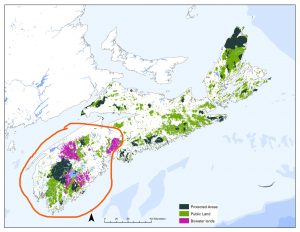When asked by a councillor “what he had to say to people alarmed by current methods”, Zwicker cited the NSDNR procedures they follow including the PTAs (Pre-Teatment Assessments). This did not reassure urban forester Jay Stone (“I’ve seen what this company does, how it cuts forest, and I can tell you no one likes it).
Zwicker, probably unwisely from WestFor’s perspective, cited “Old Natural Forest” as a challenge for WestFor due to its “dead trees and lack of silviculture treatments”. Stone commented “These are beautiful old forests, why do we have to cut them at all?”.
I would ask very much the same question, adding concerns about biodiversity and carbon storage as amongst the reasons to question any cutting in Old Natural Forest. Indeed, Zwicker’s comment illustrates how far many or most of those involved in managing forestry in Nova Scotia including, apparently, the NSDNR Minister, have to go to embrace and apply modern concepts of sustainable forestry.
In one sense I am quite empathetic to Zwicker and even the Minister. They believe that if they comply with the procedures required by NSDNR for Crown land harvests, biodiversity concerns are being taken care of. Just following those procedures requires quite specialized skills, the procedures for PTAs are internally logical, and the results are reviewed by an Integrated Resource Management (IRM) Team for the area. It all sounds scientific and duly diligent, and you can view a raft of documents on the NSDNR website that seem to support the contention that the procedures, developed over 10+ years of quite intensive research and documentation by NSDNR forestry staff, are scientifically based.
But how sound is that science? That’s the crux of what I am attempting to determine in my quest to understand forestry in Nova Scotia.
——
UPDATE 31 Mar 2017.
There is an error in the article:
“Over 2.1 million acres of land in Nova Scotia is owned by the province, meaning it is crowned land. WestFor manages 1.25 million acres of this. 52 per cent of wood from this territory in 2016 was harvested via clearcutting methods.”
From: Crown Land in Nova Scotia
What is Crown Land?
Crown lands are all or any part of the land under the administration and control of the Minister of Natural Resources. Of the 5.3 million hectares of land in Nova Scotia, about 1.53 million hectares (3.8 million acres or about 29% of the province) is designated as Crown land. In addition, most of the submerged lands (the sea bed) along the Province’s 9,000 km of coastline are also considered Crown land. Exceptions would include federally and privately owned waterlots.
The Western Crown Lands encompass “1.5 million acres of Crown land lie west of the line created by Highways 333, 213, 102 and 101 running from St. Margarets Bay to the Avon River in Windsor” of which approx. 550,000 acres are the old Bowater lands.
The Digby Courier articles states: “WestFor manages 1.25 million acres of this”; the figure may well be correct but I have not been able to find such a figure in other docs. Presumably it came from WestFor.
The article also states “52 per cent of wood from this territory in 2016 was harvested via clearcutting methods.” Undoubtedly that number came from WestFor or NSDNR. It should be noted that much or most of the other 48% likely involved partial cuts conducted in the context of even aged management which are little better than clearcuts ecologically; only selection cuts would maintain species diverse, multi-aged Acadian forest. See How much forestry in Nova Scotia maintains mixed, multi-aged Acadian forest?

